人教版七年级下册unit 10 单元复习课件(共31张PPT)
文档属性
| 名称 | 人教版七年级下册unit 10 单元复习课件(共31张PPT) | 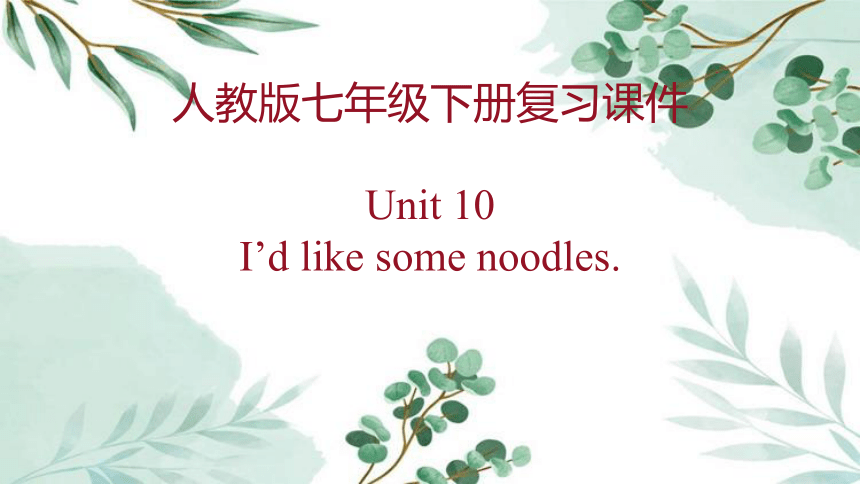 | |
| 格式 | pptx | ||
| 文件大小 | 9.5MB | ||
| 资源类型 | 教案 | ||
| 版本资源 | 人教新目标(Go for it)版 | ||
| 科目 | 英语 | ||
| 更新时间 | 2023-06-01 19:22:37 | ||
图片预览


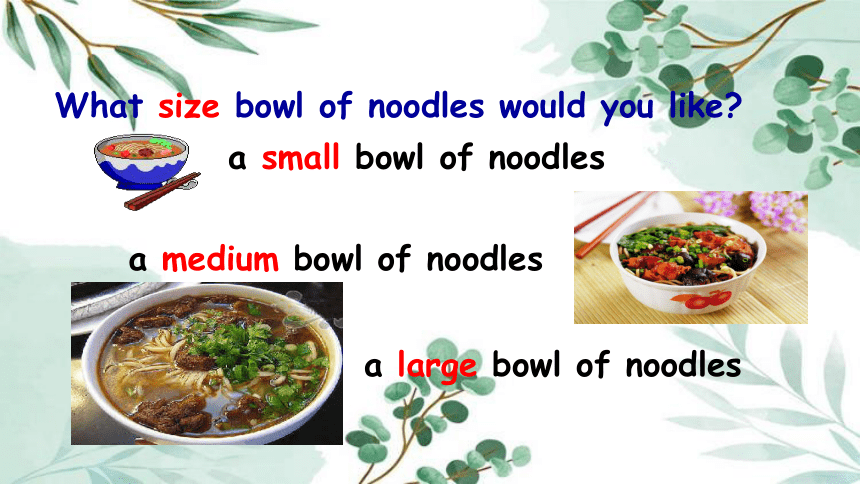
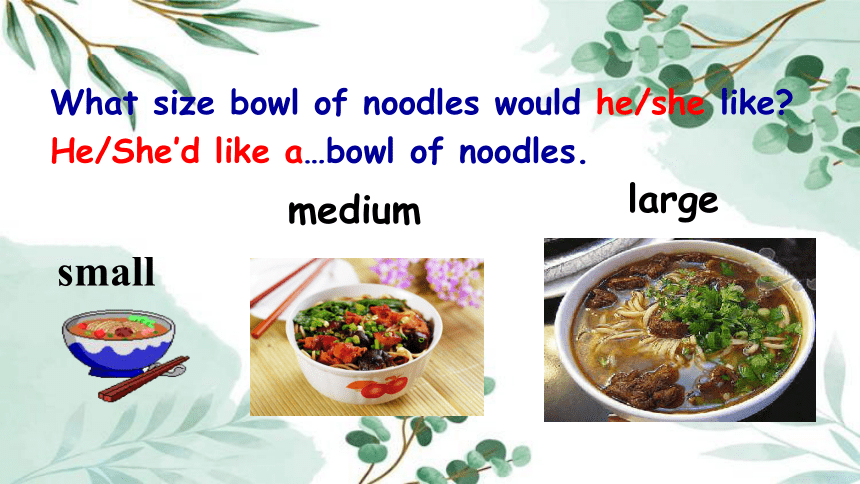
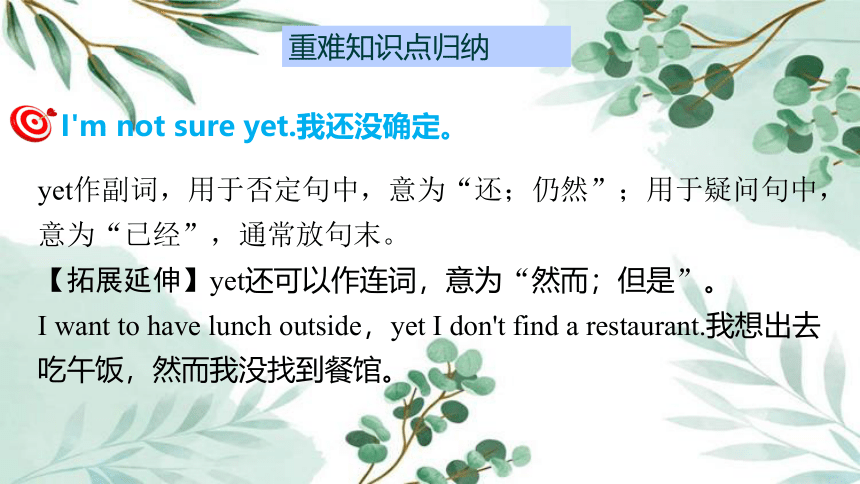
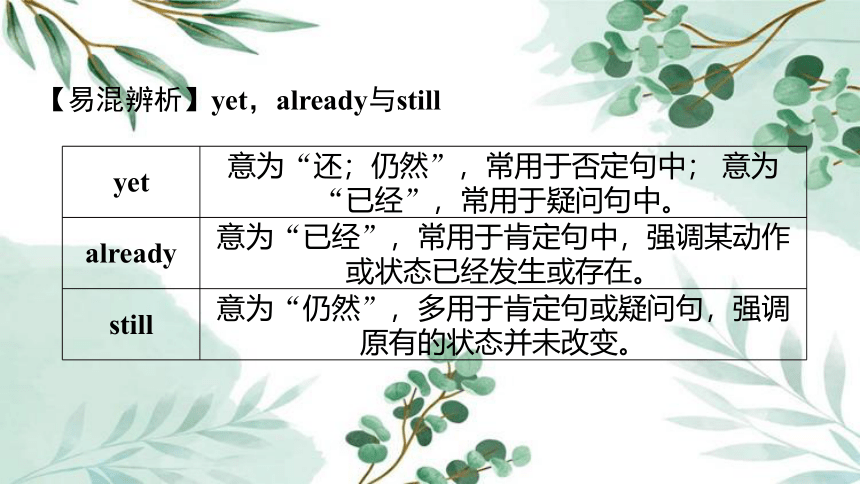
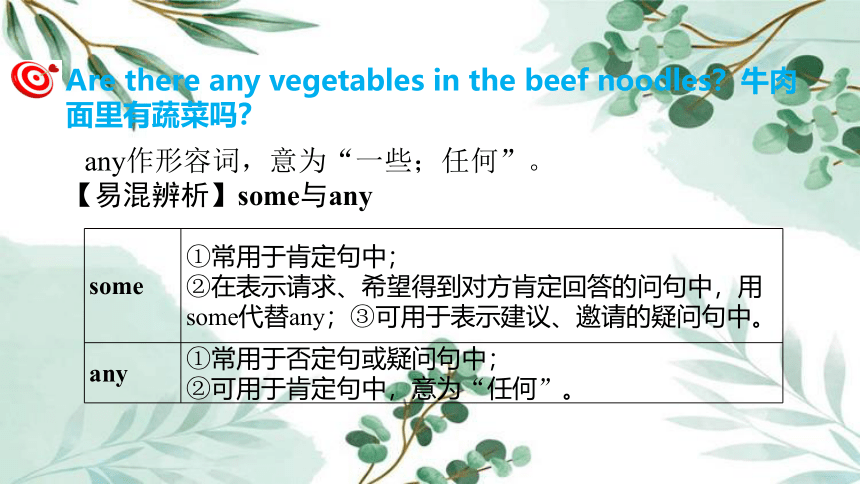
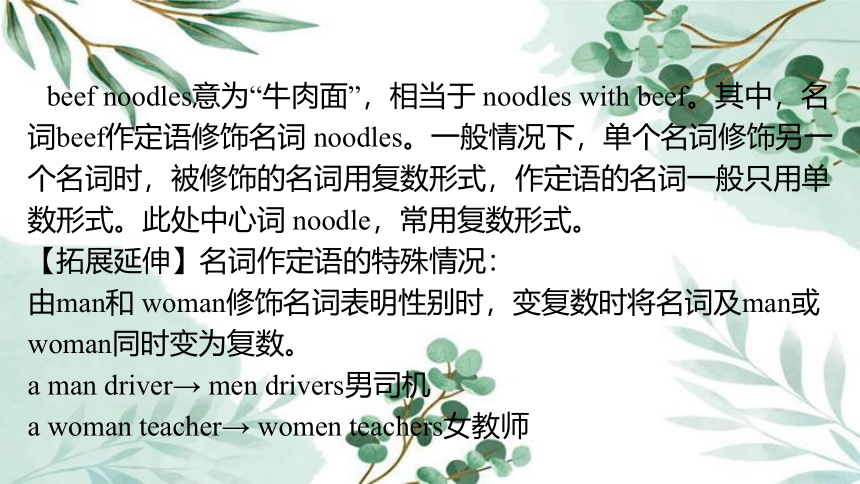
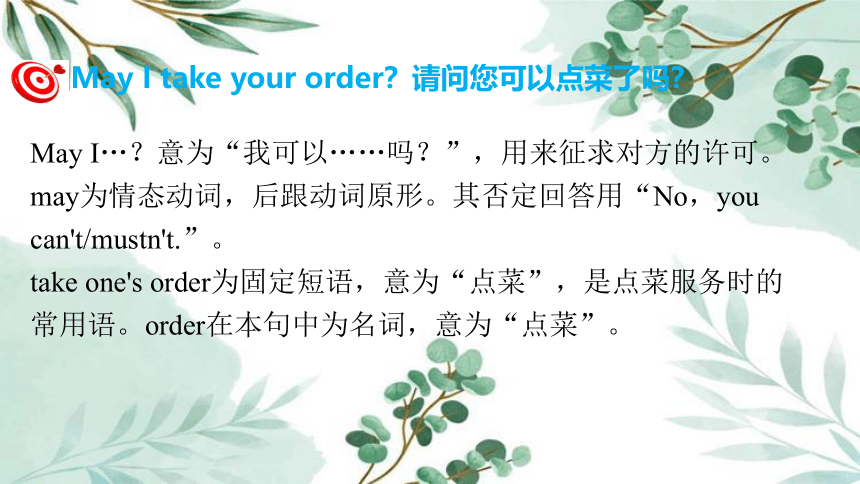
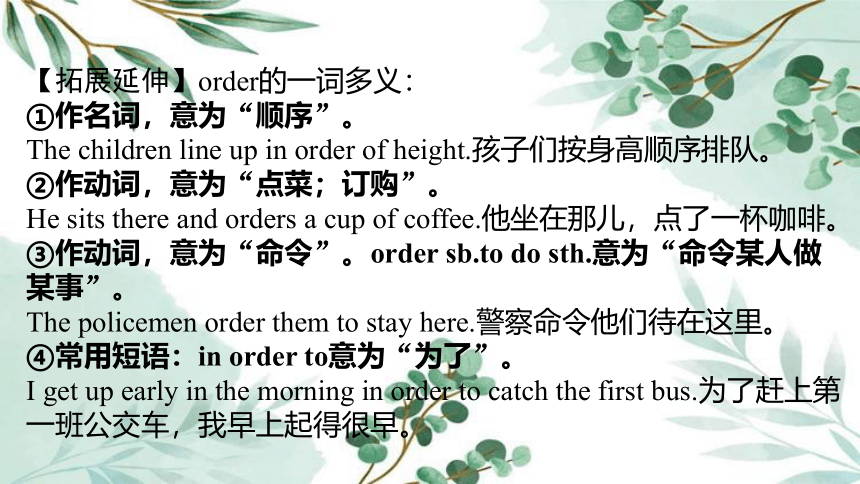


文档简介
(共31张PPT)
人教版七年级下册复习课件
Unit 10
I’d like some noodles.
Revision
What kind of noodles would you like
What size bowl of noodles would you like
a small bowl of noodles
a medium bowl of noodles
a large bowl of noodles
small
medium
large
What size bowl of noodles would he/she like
He/She’d like a…bowl of noodles.
重难知识点归纳
I'm not sure yet.我还没确定。
yet作副词,用于否定句中,意为“还;仍然”;用于疑问句中,意为“已经”,通常放句末。
【拓展延伸】yet还可以作连词,意为“然而;但是”。
I want to have lunch outside,yet I don't find a restaurant.我想出去吃午饭,然而我没找到餐馆。
【易混辨析】yet,already与still
yet 意为“还;仍然”,常用于否定句中; 意为“已经”,常用于疑问句中。
already 意为“已经”,常用于肯定句中,强调某动作或状态已经发生或存在。
still 意为“仍然”,多用于肯定句或疑问句,强调原有的状态并未改变。
Are there any vegetables in the beef noodles?牛肉面里有蔬菜吗?
any作形容词,意为“一些;任何”。
【易混辨析】some与any
some ①常用于肯定句中;
②在表示请求、希望得到对方肯定回答的问句中,用some代替any;③可用于表示建议、邀请的疑问句中。
any ①常用于否定句或疑问句中;
②可用于肯定句中,意为“任何”。
beef noodles意为“牛肉面”,相当于 noodles with beef。其中,名词beef作定语修饰名词 noodles。一般情况下,单个名词修饰另一个名词时,被修饰的名词用复数形式,作定语的名词一般只用单数形式。此处中心词 noodle,常用复数形式。
【拓展延伸】名词作定语的特殊情况:
由man和 woman修饰名词表明性别时,变复数时将名词及man或 woman同时变为复数。
a man driver→ men drivers男司机
a woman teacher→ women teachers女教师
May I take your order?请问您可以点菜了吗?
May I…?意为“我可以……吗?”,用来征求对方的许可。may为情态动词,后跟动词原形。其否定回答用“No,you can't/mustn't.”。
take one's order为固定短语,意为“点菜”,是点菜服务时的常用语。order在本句中为名词,意为“点菜”。
【拓展延伸】order的一词多义:
①作名词,意为“顺序”。
The children line up in order of height.孩子们按身高顺序排队。
②作动词,意为“点菜;订购”。
He sits there and orders a cup of coffee.他坐在那儿,点了一杯咖啡。
③作动词,意为“命令”。order sb.to do sth.意为“命令某人做某事”。
The policemen order them to stay here.警察命令他们待在这里。
④常用短语:in order to意为“为了”。
I get up early in the morning in order to catch the first bus.为了赶上第一班公交车,我早上起得很早。
The answer would be different in different countries.在不同的国家,答案会是不同的。
answer的用法
①answer此处为名词,意为“答案”。常用短语: the answer to………的答案。
②answer还可作动词,意为“回答;答复;应答”,如:answer the question/phone回答问题/接电话
different的用法
different是形容词,意为“不同的”。常用短语:be different from与……不同=be not the same as。
【拓展延伸】
different的名词形式为difference,意为“差异”,用作可数名词。常用短语:make a difference to…对……产生影响。
The birthday person must make a wish and blow out the candles.过生日的那个人必须许愿然后吹灭蜡烛。
make a wish 为固定短语,意为“许愿”,wish此处作可数名词,意为“心愿;愿望;祝愿”。
【拓展延伸】wish的其他用法:
wish作动词,意为“希望;祝愿”,常用结构:wish to do sth.希望做某事;wish sb.to do sth.希望某人做某事。
blow out为固定短语,意为“吹灭”,此处blow为不及物动词,意为“吹”。
【特别提醒】blow out为“动词+副词”型短语,代词必须放在blow与out之间,名词可以放在两词中间或者后面。
【易混辨析】yet,already与still
yet 意为“还;仍然”,常用于否定句中; 意为“已经”,常用于疑问句中。
already 意为“已经”,常用于肯定句中,强调某动作或状态已经发生或存在。
still 意为“仍然”,多用于肯定句或疑问句,强调原有的状态并未改变。
Are there any vegetables in the beef noodles?牛肉面里有蔬菜吗?
any作形容词,意为“一些;任何”。
【易混辨析】some与any
some ①常用于肯定句中;
②在表示请求、希望得到对方肯定回答的问句中,用some代替any;③可用于表示建议、邀请的疑问句中。
any ①常用于否定句或疑问句中;
②可用于肯定句中,意为“任何”。
beef noodles意为“牛肉面”,相当于 noodles with beef。其中,名词beef作定语修饰名词 noodles。一般情况下,单个名词修饰另一个名词时,被修饰的名词用复数形式,作定语的名词一般只用单数形式。此处中心词 noodle,常用复数形式。
【拓展延伸】名词作定语的特殊情况:
由man和 woman修饰名词表明性别时,变复数时将名词及man或 woman同时变为复数。
a man driver→ men drivers男司机
a woman teacher→ women teachers女教师
What kind of noodles would you like I’d like beef noodles, please.
What size would you like I’d like a large bowl, please.
Would you like a large bowl Yes, please.
Is there any meat in the tomato and egg soup No, there isn’t any. /
No, there’s no meat.
I’d = I would
She’d =She would
Grammar Focus
1. 你想要什么面条?
___________________________________
2. 请给我来牛肉面。
___________________________________
3. 你想要什么碗的?
___________________________________
阅读Grammar Focus部分, 完成下列句子。
I’d like beef noodles, please.
What kind of noodles would you like
What size would you like
4. 请给我来中碗的。
___________________________
5. 你想来一个大碗吗?
___________________________
6. 好的。
___________________________
I’d like a medium bowl, please.
Would you like a large bowl
Yes, please.
7. 在西红柿鸡蛋汤里有肉吗
_____________________________
_____________________________
不,没有。
_____________________________
_____________________________
No, there isn’t any. /
No, there’s no meat.
Is there any meat in the tomato
and egg soup
(1) Would you like + some +名词/代词
常用于征求对方的意见。
答语:Yes, please. / No, thanks.
(2) Would you like + to do sth.
表示向对方有礼貌地提出建议或发出邀请。
答语:Yes, I’d love/like to.
或 I’d love/like to, but…
would like 的常用句型
Countable nouns Uncountable nouns Countable and uncountable nouns
bowls, apples, carrots, oranges, strawberries beef, meat, milk, mutton, water chicken, salad,
ice-cream, cabbage, cake
可数名词和不可数名词
可数名词与不可数名词用法对比
可数名词 不可数名词
有单数和复数之分。如:a box, two boxes。 没有复数形式。如:beef, mutton, meat, milk。
(1) 其前可直接用不定冠词a/an或具体的数词修饰,表示数量。如:a bowl ,an orange, two potatoes。 (2) 可用定冠词the修饰,表示特指,如:the girl(这个女孩)。 (1) 其前不能用不定冠词a/an或数词修饰。
(2) 可用定冠词the修饰,表示特指,如:the bread(这块面包)。
可用some, any, few, a few, many, lots of, a lot of等修饰。 可用some, any, little, a little, much, a lot of, lots of等修饰。
询问数量多少用how many。 询问量的多少用how much。
不可数名词量的表达
不可数名词的量可以用 “a/an/基数词+表示量的名词 + of + 不可数名词” 表示,这些表示量的名词有单复数形式的变化。这一结构作主语时,谓语动词的单复数形式要与表示量的名词保持一致。
There is a bottle of juice on the table. 桌子上有一瓶果汁。(谓语动词is与a bottle保持一致)
There are three bowls of mutton soup on the table. 桌子上有三碗羊肉汤。(谓语动词are与three bowls保持一致)
本单元的话题是“食物”,要求学生能围绕这一话题为餐馆写一则广告。在写作时,首先要正确使用谈论食物的句型;其次要注意区分可数名词与不可数名词;最后要注意广告和海报的特点。
话题概述
假如你是 Becky ,你叔叔的新餐厅 House of Dumplings 这周日即将开业。请你根据下面菜单的信息帮他在网上发布一则广告,以吸引更多的顾客。
要求:语句通顺,用词准确,表达流畅;不少于60词。
经典例题
文体:应用文 人称:以第一人称和第二人称为主
时态:一般现在时
Specials Prices
Cabbage dumplings $6
Mutton dumplings $10
Beef and carrot dumplings $10
Buy 24 dumplings and get a free bowl of tomato and egg soup.
15 minutes
谋篇布局
开门见山
House of Dumplings will open…Would you like to eat… Please come to…
具体介绍
In our restaurant, there are different kinds of...
We have three specials.
Would you like... or... We sell... for ...
You can also order...
If you buy…, you can get...
招揽顾客
Come and enjoy… I’m sure you will…
House of Dumplings
House of Dumplings will open this Sunday. Would you like to eat some dumplings Please come to our restaurant!
In our restaurant, there are different kinds of dumplings. We have three specials. Would you like mutton dumplings or beef and carrot dumplings
开门见山
具体介绍
We sell 12 dumplings for only $10. You can also order cabbage dumplings. 12 of them are only $6. We have another good news for you. If you buy 24 dumplings, you can get a bowl of tomato and egg soup for free.
Come and enjoy our delicious dumplings. I’m sure you will love them.
招揽顾客
具体介绍
人教版七年级下册复习课件
Unit 10
I’d like some noodles.
Revision
What kind of noodles would you like
What size bowl of noodles would you like
a small bowl of noodles
a medium bowl of noodles
a large bowl of noodles
small
medium
large
What size bowl of noodles would he/she like
He/She’d like a…bowl of noodles.
重难知识点归纳
I'm not sure yet.我还没确定。
yet作副词,用于否定句中,意为“还;仍然”;用于疑问句中,意为“已经”,通常放句末。
【拓展延伸】yet还可以作连词,意为“然而;但是”。
I want to have lunch outside,yet I don't find a restaurant.我想出去吃午饭,然而我没找到餐馆。
【易混辨析】yet,already与still
yet 意为“还;仍然”,常用于否定句中; 意为“已经”,常用于疑问句中。
already 意为“已经”,常用于肯定句中,强调某动作或状态已经发生或存在。
still 意为“仍然”,多用于肯定句或疑问句,强调原有的状态并未改变。
Are there any vegetables in the beef noodles?牛肉面里有蔬菜吗?
any作形容词,意为“一些;任何”。
【易混辨析】some与any
some ①常用于肯定句中;
②在表示请求、希望得到对方肯定回答的问句中,用some代替any;③可用于表示建议、邀请的疑问句中。
any ①常用于否定句或疑问句中;
②可用于肯定句中,意为“任何”。
beef noodles意为“牛肉面”,相当于 noodles with beef。其中,名词beef作定语修饰名词 noodles。一般情况下,单个名词修饰另一个名词时,被修饰的名词用复数形式,作定语的名词一般只用单数形式。此处中心词 noodle,常用复数形式。
【拓展延伸】名词作定语的特殊情况:
由man和 woman修饰名词表明性别时,变复数时将名词及man或 woman同时变为复数。
a man driver→ men drivers男司机
a woman teacher→ women teachers女教师
May I take your order?请问您可以点菜了吗?
May I…?意为“我可以……吗?”,用来征求对方的许可。may为情态动词,后跟动词原形。其否定回答用“No,you can't/mustn't.”。
take one's order为固定短语,意为“点菜”,是点菜服务时的常用语。order在本句中为名词,意为“点菜”。
【拓展延伸】order的一词多义:
①作名词,意为“顺序”。
The children line up in order of height.孩子们按身高顺序排队。
②作动词,意为“点菜;订购”。
He sits there and orders a cup of coffee.他坐在那儿,点了一杯咖啡。
③作动词,意为“命令”。order sb.to do sth.意为“命令某人做某事”。
The policemen order them to stay here.警察命令他们待在这里。
④常用短语:in order to意为“为了”。
I get up early in the morning in order to catch the first bus.为了赶上第一班公交车,我早上起得很早。
The answer would be different in different countries.在不同的国家,答案会是不同的。
answer的用法
①answer此处为名词,意为“答案”。常用短语: the answer to………的答案。
②answer还可作动词,意为“回答;答复;应答”,如:answer the question/phone回答问题/接电话
different的用法
different是形容词,意为“不同的”。常用短语:be different from与……不同=be not the same as。
【拓展延伸】
different的名词形式为difference,意为“差异”,用作可数名词。常用短语:make a difference to…对……产生影响。
The birthday person must make a wish and blow out the candles.过生日的那个人必须许愿然后吹灭蜡烛。
make a wish 为固定短语,意为“许愿”,wish此处作可数名词,意为“心愿;愿望;祝愿”。
【拓展延伸】wish的其他用法:
wish作动词,意为“希望;祝愿”,常用结构:wish to do sth.希望做某事;wish sb.to do sth.希望某人做某事。
blow out为固定短语,意为“吹灭”,此处blow为不及物动词,意为“吹”。
【特别提醒】blow out为“动词+副词”型短语,代词必须放在blow与out之间,名词可以放在两词中间或者后面。
【易混辨析】yet,already与still
yet 意为“还;仍然”,常用于否定句中; 意为“已经”,常用于疑问句中。
already 意为“已经”,常用于肯定句中,强调某动作或状态已经发生或存在。
still 意为“仍然”,多用于肯定句或疑问句,强调原有的状态并未改变。
Are there any vegetables in the beef noodles?牛肉面里有蔬菜吗?
any作形容词,意为“一些;任何”。
【易混辨析】some与any
some ①常用于肯定句中;
②在表示请求、希望得到对方肯定回答的问句中,用some代替any;③可用于表示建议、邀请的疑问句中。
any ①常用于否定句或疑问句中;
②可用于肯定句中,意为“任何”。
beef noodles意为“牛肉面”,相当于 noodles with beef。其中,名词beef作定语修饰名词 noodles。一般情况下,单个名词修饰另一个名词时,被修饰的名词用复数形式,作定语的名词一般只用单数形式。此处中心词 noodle,常用复数形式。
【拓展延伸】名词作定语的特殊情况:
由man和 woman修饰名词表明性别时,变复数时将名词及man或 woman同时变为复数。
a man driver→ men drivers男司机
a woman teacher→ women teachers女教师
What kind of noodles would you like I’d like beef noodles, please.
What size would you like I’d like a large bowl, please.
Would you like a large bowl Yes, please.
Is there any meat in the tomato and egg soup No, there isn’t any. /
No, there’s no meat.
I’d = I would
She’d =She would
Grammar Focus
1. 你想要什么面条?
___________________________________
2. 请给我来牛肉面。
___________________________________
3. 你想要什么碗的?
___________________________________
阅读Grammar Focus部分, 完成下列句子。
I’d like beef noodles, please.
What kind of noodles would you like
What size would you like
4. 请给我来中碗的。
___________________________
5. 你想来一个大碗吗?
___________________________
6. 好的。
___________________________
I’d like a medium bowl, please.
Would you like a large bowl
Yes, please.
7. 在西红柿鸡蛋汤里有肉吗
_____________________________
_____________________________
不,没有。
_____________________________
_____________________________
No, there isn’t any. /
No, there’s no meat.
Is there any meat in the tomato
and egg soup
(1) Would you like + some +名词/代词
常用于征求对方的意见。
答语:Yes, please. / No, thanks.
(2) Would you like + to do sth.
表示向对方有礼貌地提出建议或发出邀请。
答语:Yes, I’d love/like to.
或 I’d love/like to, but…
would like 的常用句型
Countable nouns Uncountable nouns Countable and uncountable nouns
bowls, apples, carrots, oranges, strawberries beef, meat, milk, mutton, water chicken, salad,
ice-cream, cabbage, cake
可数名词和不可数名词
可数名词与不可数名词用法对比
可数名词 不可数名词
有单数和复数之分。如:a box, two boxes。 没有复数形式。如:beef, mutton, meat, milk。
(1) 其前可直接用不定冠词a/an或具体的数词修饰,表示数量。如:a bowl ,an orange, two potatoes。 (2) 可用定冠词the修饰,表示特指,如:the girl(这个女孩)。 (1) 其前不能用不定冠词a/an或数词修饰。
(2) 可用定冠词the修饰,表示特指,如:the bread(这块面包)。
可用some, any, few, a few, many, lots of, a lot of等修饰。 可用some, any, little, a little, much, a lot of, lots of等修饰。
询问数量多少用how many。 询问量的多少用how much。
不可数名词量的表达
不可数名词的量可以用 “a/an/基数词+表示量的名词 + of + 不可数名词” 表示,这些表示量的名词有单复数形式的变化。这一结构作主语时,谓语动词的单复数形式要与表示量的名词保持一致。
There is a bottle of juice on the table. 桌子上有一瓶果汁。(谓语动词is与a bottle保持一致)
There are three bowls of mutton soup on the table. 桌子上有三碗羊肉汤。(谓语动词are与three bowls保持一致)
本单元的话题是“食物”,要求学生能围绕这一话题为餐馆写一则广告。在写作时,首先要正确使用谈论食物的句型;其次要注意区分可数名词与不可数名词;最后要注意广告和海报的特点。
话题概述
假如你是 Becky ,你叔叔的新餐厅 House of Dumplings 这周日即将开业。请你根据下面菜单的信息帮他在网上发布一则广告,以吸引更多的顾客。
要求:语句通顺,用词准确,表达流畅;不少于60词。
经典例题
文体:应用文 人称:以第一人称和第二人称为主
时态:一般现在时
Specials Prices
Cabbage dumplings $6
Mutton dumplings $10
Beef and carrot dumplings $10
Buy 24 dumplings and get a free bowl of tomato and egg soup.
15 minutes
谋篇布局
开门见山
House of Dumplings will open…Would you like to eat… Please come to…
具体介绍
In our restaurant, there are different kinds of...
We have three specials.
Would you like... or... We sell... for ...
You can also order...
If you buy…, you can get...
招揽顾客
Come and enjoy… I’m sure you will…
House of Dumplings
House of Dumplings will open this Sunday. Would you like to eat some dumplings Please come to our restaurant!
In our restaurant, there are different kinds of dumplings. We have three specials. Would you like mutton dumplings or beef and carrot dumplings
开门见山
具体介绍
We sell 12 dumplings for only $10. You can also order cabbage dumplings. 12 of them are only $6. We have another good news for you. If you buy 24 dumplings, you can get a bowl of tomato and egg soup for free.
Come and enjoy our delicious dumplings. I’m sure you will love them.
招揽顾客
具体介绍
同课章节目录
- Unit 1 Can you play the guitar?
- Section A
- Section B
- Unit 2 What time do you go to school?
- Section A
- Section B
- Unit 3 How do you get to school?
- Section A
- Section B
- Unit 4 Don't eat in class.
- Section A
- Section B
- Unit 5 Why do you like pandas?
- Section A
- Section B
- Unit 6 I'm watching TV.
- Section A
- Section B
- Review of Units 1-6
- Unit 7 It's raining!
- Section A
- Section B
- Unit 8 Is there a post office near here?
- Section A
- Section B
- Unit 9 What does he look like?
- Section A
- Section B
- Unit 10 I'd like some noodles.
- Section A
- Section B
- Unit 11 How was your school trip?
- Section A
- Section B
- Unit 12 What did you do last weekend?
- Section A
- Section B
